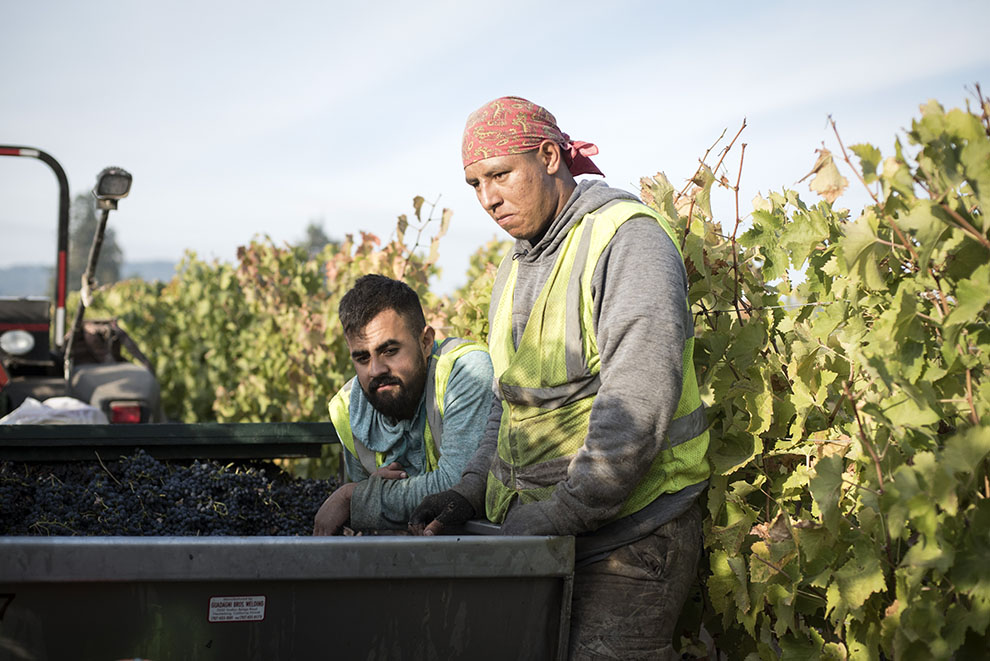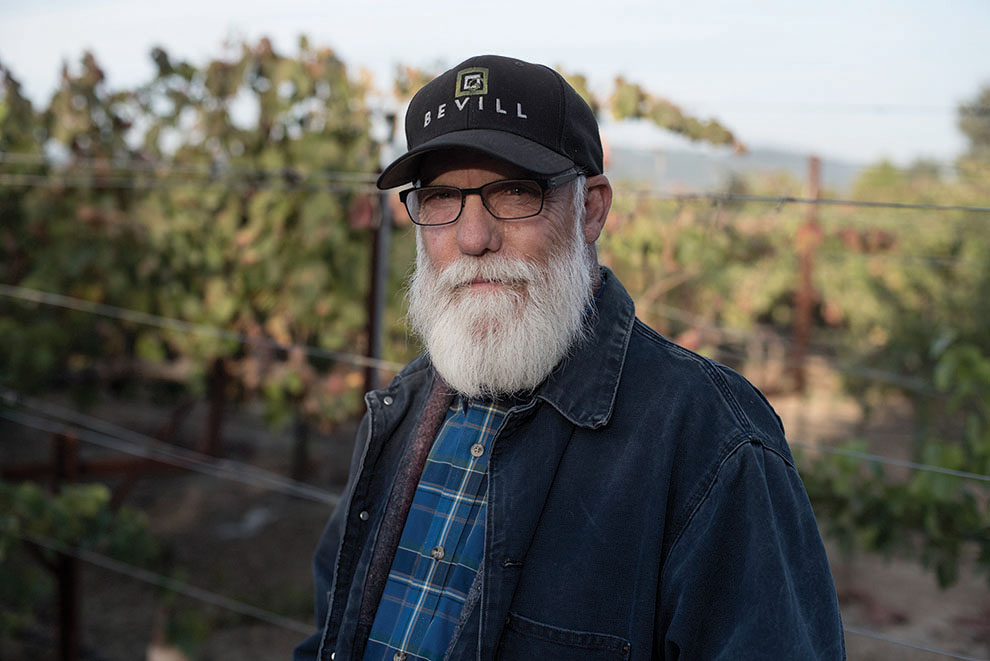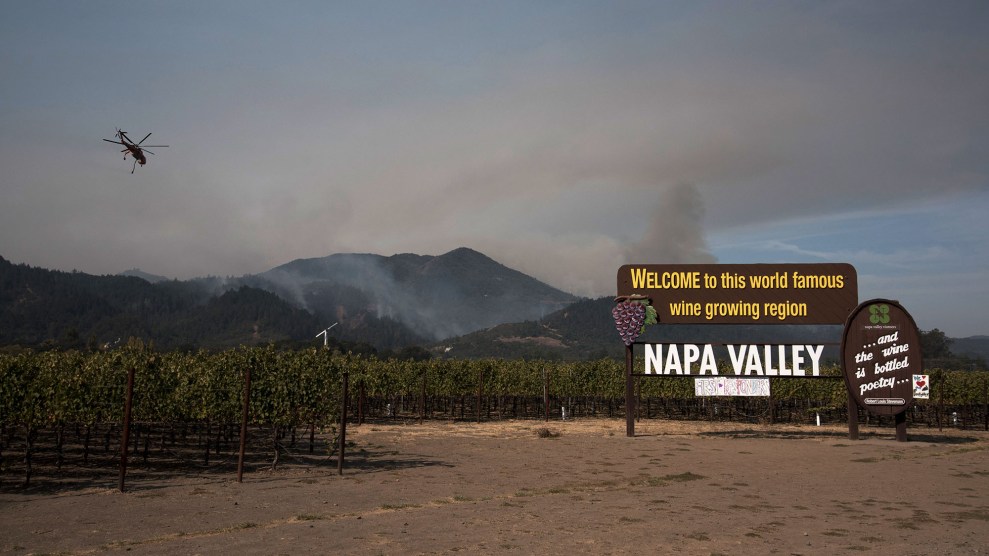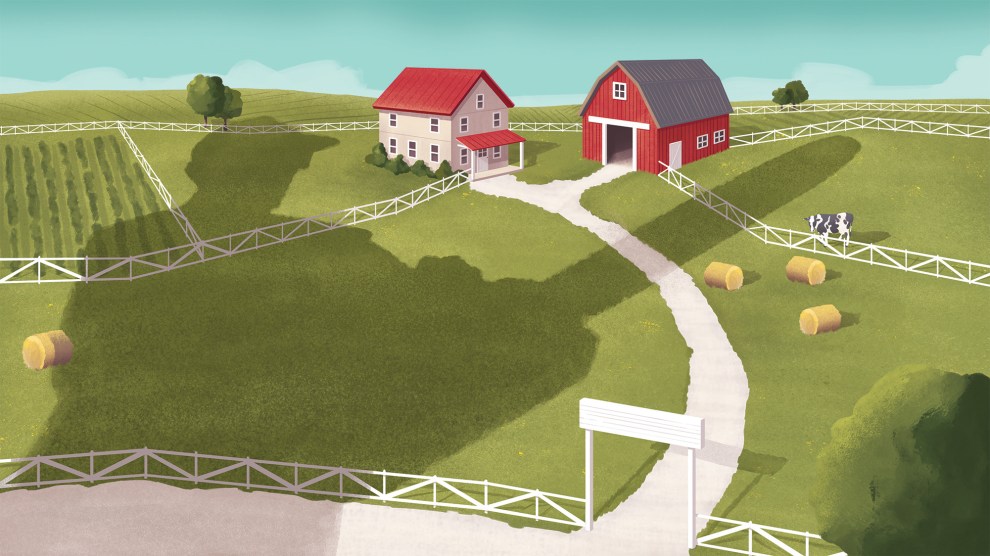It’s Sunday night of Labor Day weekend, but any barbecues died down hours ago, and the rural back roads of this southern Napa County neighborhood are a dark and silent maze. Around midnight, the lights of the Robert Sinskey Vineyards’ shop blink on. In the center of its gravel driveway, workers coax tractors to life and assemble large plastic bins that will soon brim with clusters of pale green pinot blanc grapes. Picked in the cool hours of the early morning, before their sugars can develop in the sunlight, the grapes will then be whisked off to the winery and prepared for fermentation.
As 1 a.m. nears, a white van pulls up and a crew of about nine pickers, contracted by Rios Farming Co., clamber out to don neon-colored vests and headlamps. They’ve traveled two hours from Stockton, California, to be here, and for the next 10 hours or so they will together pick 25 tons of fruit.
Vineyard manager Debby Zygielbaum leads the group in a stretching circle despite her stiff work pants and then gives the call to start. In one swift motion, the workers lift small plastic bins onto their heads and begin running into the rows. They use clippers to quickly snip the grapes, 45 clusters per minute by my count, taking care not to crush the bulbous fruit or snag the leaves.
Clipboard in hand, Sergio Agustin Sanchez, the crew’s stubble-faced supervisor, paces after them. Pickers emptying their bins yell out to be recorded, and the deluge of calls punctuates the din of the tractor. Sanchez must concentrate to hear every shout, but he’s grateful there are enough voices. A few weeks earlier, the labor contracting company he works for had to scramble to replace crews. Ten years ago, he reviewed 700 job applications for each season. Last year, he tells me, he saw maybe 15. “There aren’t any people now,” he says.

President Donald Trump has called for a crackdown on immigrants because he says they “compete directly against vulnerable American workers.” But to California’s grape growers, this claim is laughable. According to Manuel Rios, the owner of the company supplying Sinskey with its contract labor, “Nobody wants these jobs.” The shortage is part of a larger trend in agriculture, one that has sparked a race “between rising imports, more machines, and foreign guest workers,” in the words of agricultural economist Philip Martin. And in this race, he writes, the Trump administration’s policies “will determine the winner.”
In 1976, California’s vineyards shot to international prominence after two Napa Valley wines blew away blindfolded judges at a Parisian taste test. Since then, the amount of wine Americans drink has risen by 70 percent to three gallons per person annually; the United States now consumes more by volume than any other country, according to the Wine Institute. California generates $34 billion of the nation’s $60 billion domestic wine sales and nearly $115 billion annually in economic activity when you include employment and tax revenue.
Napa and Sonoma counties produce most of the state’s high-end grapes in their combined 1,000 wineries. Like the rest of the state’s agriculture, the industry has long relied on immigrant workers for its heaviest labor. As of 2016, according to a federal survey, 9 out of 10 California farmworkers were born abroad, mostly in Mexico, and half were here without citizenship or legal work permits. But employers often have no way of knowing the immigration status of workers.
Over the last few decades, millions of Mexicans have come north to work on US farms. But in the last few years, the migrations have slowed: The journey became more expensive and more dangerous, and the 2008 recession took hold. What’s more, during that time Mexico’s economy improved, and its rural poverty decreased. “This is a case where what’s good for Mexico creates big challenges for California farmers,” says University of California-Davis professor J. Edward Taylor, who estimates that the number of farmworkers coming out of rural Mexico is declining by about 150,000, or roughly 1 percent, a year. On top of this, the foreign-born farmworkers who have settled in the states are aging out, and their children, as with American-born farm kids, aren’t following them into the fields.
The Trump administration’s stance on immigration could scare off even more workers. President Barack Obama’s administration deported more than 5 million people over the course of eight years, but it prioritized those with criminal records. During Trump’s first year in office, deportation arrests of undocumented immigrants without rap sheets more than doubled. Immigration policy advocate Ed Kissam, who has led studies on farmworkers for the Labor Department, analyzed Trump’s proposed immigration policies and found that they pose a “major threat” to California’s economic well-being. If all the orders were to take effect, he concluded, the state could lose 5 to 10 percent of its agricultural labor force by 2020. In March, a large sweep by Immigration and Customs Enforcement agents across Central and Northern California sent 26 farmworkers into deportation proceedings, many of whom appeared to have no criminal history, the Los Angeles Times reported. Juan Hernandez, executive director of Sonoma’s La Luz Center, a nonprofit supporting immigrant families, told me that it’s hard for his clients to separate rumors of raids from reality, so they’re always on alert. “Are we fearful in Sonoma Valley? Of course.”

At a winery in Sonoma County, workers harvest grapes early in the morning.
Mark Murrmann
And advocates worry the new enforcement policies jeopardize the gains they’ve made for workers’ rights in farm country. At an April conference on immigration and California agriculture, Cynthia Rice, an attorney with California Rural Legal Assistance, reported that since the change in administration, her clients (who are all in this country legally) have gone to her not only with concerns about wage theft or inadequate housing, but also “with the fear that their cousin or their wife is subject to deportation if they come forward.” This approach to immigration enforcement “empowers the worst parts of our society,” she said.
Last summer, Rios Farming Co., which supplies pickers to Robert Sinskey and 12 other wineries, was short 60 or 70 people, a problem that owner Manuel Rios attributed in part to immigration policies. “Some of the people that had work visas were unable to renew them,” he said. “They got the border set off so tight that it costs $12,000 to $14,000 to get someone across.” Normally by July, his crews would have had wires lifted and all the canopy management done, but they were three weeks behind “because we can’t find enough people.”
Couldn’t Rios just recruit American workers? Not likely, according to the economists I interviewed. Because of low wages and grueling conditions, vineyard jobs don’t attract people born in the United States. California growers boast their pay has gone up steadily for years—Napa has the highest average farmworker wages in the state. Yet economist Martin doubts farmers will ever pay enough to lure US-born workers into the fields. “I think there is some wage at which Americans would do some work, but suppose it’s $25 an hour,” he says. Before we hit that amount, he explains, robots or cheaper imports will swoop in.
Indeed, many bulk wineries in the Central Valley and the largest operations in Napa and Sonoma have started to mechanize—even for some of the delicate preharvest pruning. But at $350,000, the French mechanical picker called the Pellenc is out of reach for smaller operations, and it does not work well on hilly terrain. And some high-end growers are reluctant to embrace mechanization because “there’s a belief that for the kind of craft wines that are going to be produced here, the human component can’t be replicated,” says Rob McMillan, an industry analyst and head of the Silicon Valley Bank’s wine division. As Zygielbaum, now a vineyard consultant, put it*, “There’s a certain level of quality that you’re just going to get with two opposable thumbs and a brain.”
A mechanical harvester works by shaking a vine so fast the grapes fall off, leaving behind the rachis stem—the main axis of each cluster—and splitting some of the individual grapes. Kathleen Inman, who owns a small winery and an eight-acre vineyard in Sonoma’s Russian River Valley, prefers to use entire bunches during the fermentation process; she says the rachises “act like a cage to protect some of the berries” and lend flavor and texture. When a grape’s skin splits, “you’re losing the chance to have the fermentation happen inside the berry,” she explains.
So Inman hires contractor Jim Pratt to recruit crews to do the picking manually. Pratt says he started having trouble finding workers in 2011. While the pinch began during the Obama administration, it tightened last year. “Trump has been more vocal,” he said—“more threatening to employees.”
The undocumented workers I talked with when I was in wine country echoed those concerns. One picker, whom I’ll call Ulises, told me that Trump made him feel unwanted. “He created this anxiety. You could just be working here, doing everything normally, and bad luck will hit.”

Grape pickers in Sonoma County pause in the middle of a busy harvest day.
Mark Murrman
Last year, Ulises worked with a Napa-based contract crew. The 33-year-old grew up in Durango, Mexico, where he hauled away pine trees from the Sierra Madre mountains while working for his father’s timber operation as a truck driver. He heard rumors of easy riches to be found in the United States. “They would say, ‘Over there you can find dollars thrown everywhere,’” he remembers. When he turned 21, he moved to California, landing factory jobs in Yuba City, a working-class town north of Sacramento supposedly named after uva, Spanish for “grape.”
Over the next 12 years, Ulises got married and had three kids, and he found seasonal work in Napa’s vineyards that paid $6.50 more an hour than his factory gig. Even so, he had trouble affording the steep cost of housing near Napa—about $1,600 for a two-bedroom apartment—so he commuted four hours every day. He woke up at 2:30 a.m., downed a glass of milk, and slipped out of his house to pick up several of his co-workers. He steered his Honda onto the highway before sunlight could smudge the horizon and flicked on the radio, toggling between the Spanish news channel and any music loud enough to keep him awake. He worked six days a week. Yet he couldn’t save anything.
Since then, Ulises has found a job at a wood factory closer to his home. Still, these days he thinks more and more of transplanting his family back to Durango. Because he can’t return to Mexico for a visit without fear of apprehension, he hasn’t seen his parents for more than a decade. Several friends are contemplating the same move. “We’re alone here,” he tells me, running his fingers over a stalk of grass, as if caught in a memory.
After struggling for five years to attract the field hands he once depended on, vineyard manager Duff Bevill decided to try something different: import them himself. He hired an attorney and applied for a Labor Department program called H-2A, allowing him to bring in workers from Mexico for up to one year.
After a six-month application process, Bevill lined up a charter bus and went down to the American consulate in Tijuana to meet 24 new members of his crew. Most came from the same town in Jalisco state as one of his foremen, Armando Mesa. The program requires employers in California to cover transportation, pay visa holders more than the federal minimum wage, and provide them with federally approved housing. Bevill’s crew shacked up in a bunkhouse on the property of one of his clients near the airport in Santa Rosa.

Vineyard manager Duff Bevill brings his pickers from Mexico with temporary visas.
Mark Murrmann
For their five-month stint, the men depended on Bevill’s company to travel around the area. Mesa picked them up on the weekends to run errands. He’d sometimes take them out for a meal, but most nights they cooked guisados (meat stews) in the dorm, where they weren’t permitted to drink alcohol. One weekend, Mesa drove some of them south to glimpse the Golden Gate Bridge.
Bevill said he was happy with the first season with this crew, who “aren’t afraid to work,” and that all of them wanted to return. Since 2011, California has seen a steady rise in applications for H-2A visas, including a dramatic increase in applications for vineyard workers. Trump has signaled he supports more guest workers: His son Eric has regularly applied for H-2A holders to staff his Virginia winery. The House Judiciary Committee approved a bill in October that, if enacted, would make it easier for farmers to import this type of employee.
The trend worries many farm labor advocates. “Guest workers are very much controlled by their employer and tend to be very productive because they are working in fear of being fired or deported,” argues Bruce Goldstein, the president of the nonprofit Farmworker Justice. The inability to bring their families further isolates these crews. “The people on our farms deserve the opportunity to be part of our social fabric,” Goldstein says. California Rural Legal Assistance’s Rice, who regularly reviews H-2A orders, notes that H-2A workers can be prohibited from receiving visitors: “How better to exclude a whole workforce population from the community that they live in than to not allow them to have visitors in their homes?” She adds that the program places an unfair burden on the towns housing the guest workers, because they can strain public services. “That’s not a social or economic model that rural communities in California can afford to invest in,” she argues.
As Napa’s hectic harvest drew to a close last fall, disaster struck. On the evening of October 8, wind gusts upward of 60 mph stoked more than 100 wildfires, including the Atlas fire just east of the historic Silverado Trail. It burned up to the periphery of the Robert Sinskey winery, singeing vines and stopping short of a propane tank next to the back entrance. Another blaze ignited in Carneros, one mile from three other Sinskey plots. The fires leaped over highways, reducing barns to black shreds and destroying more than 6,400 homes, worsening the area’s housing crisis.
Vineyard manager Zygielbaum evacuated for nine days, and she told her crews to stay home with their families. She watched in shock as wineries sent pickers out “while the fires were actively raging and the smoke was worse than Beijing,” she remembered a few months later. “It kind of broke me a bit,” Zygielbaum said. The profit margins are so tight, she added, that “the grapes become more important than lives.”
This story was supported by the University of California-Berkeley 11th Hour Food and Farming Journalism Fellowship.
*Debby Zygielbaum was killed on November 8, 2018, after a truck crossed into her lane and struck her car in a head-on collision.

















